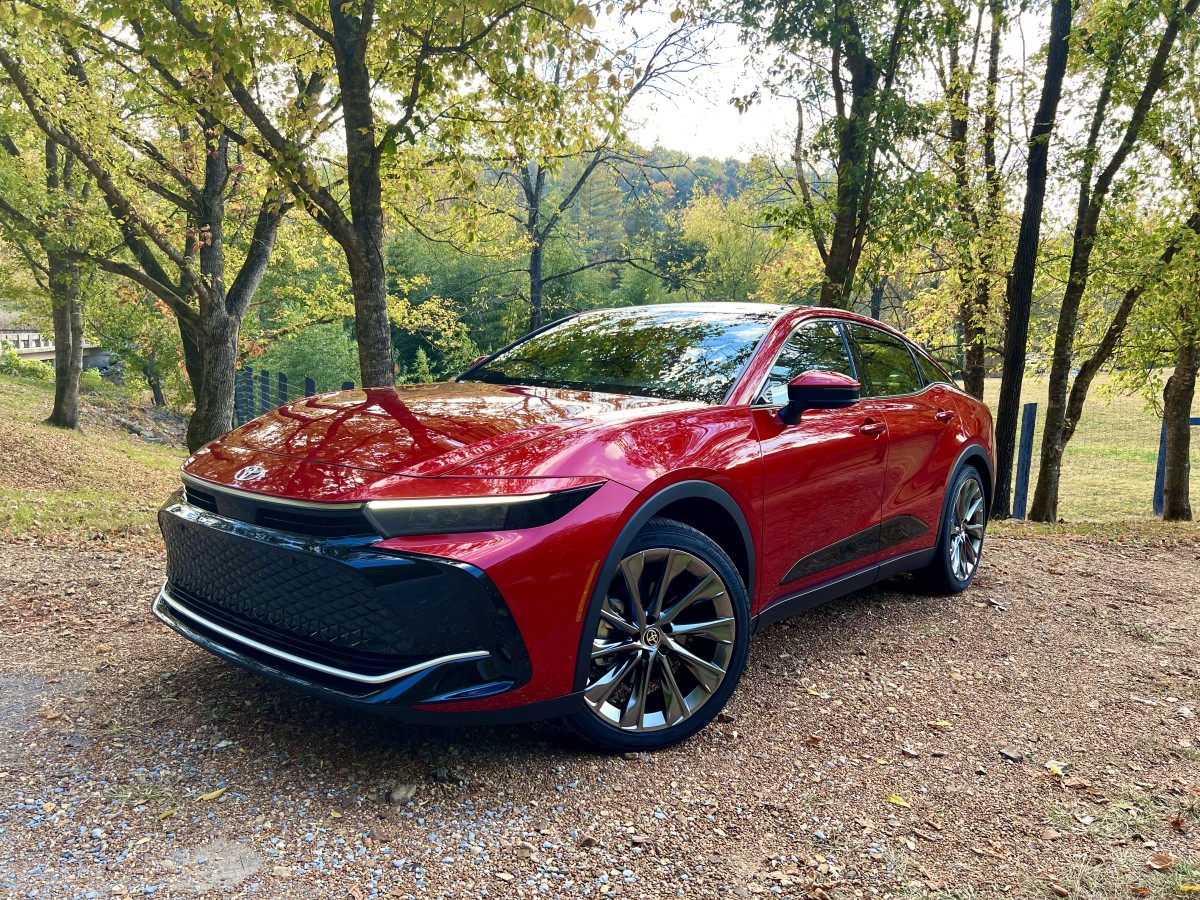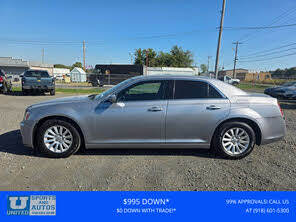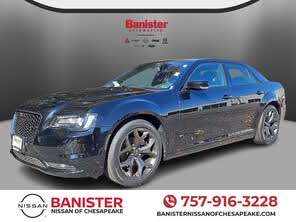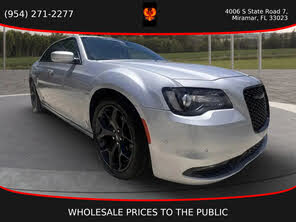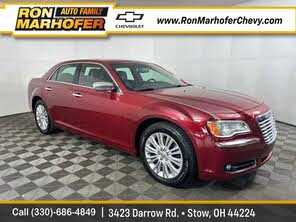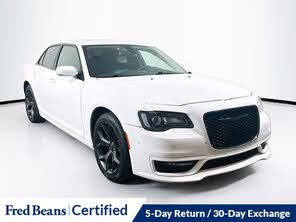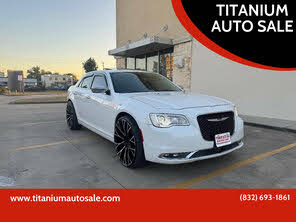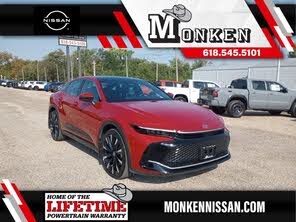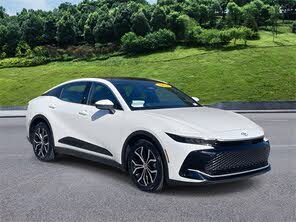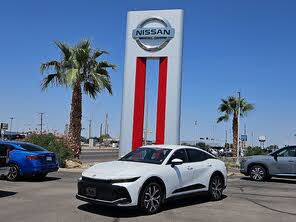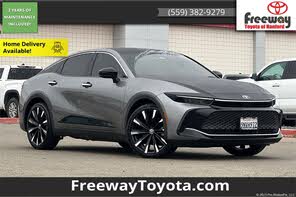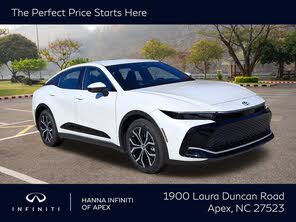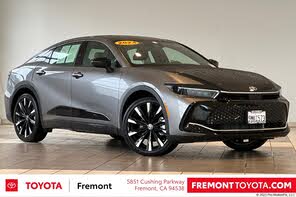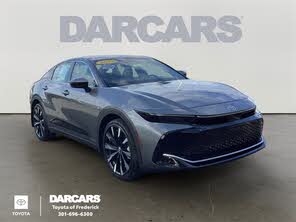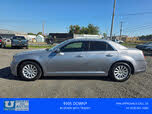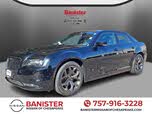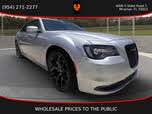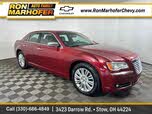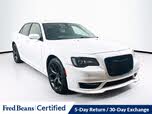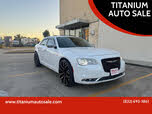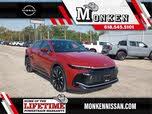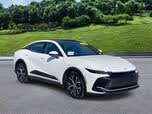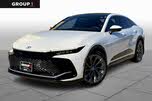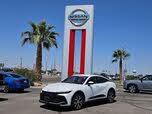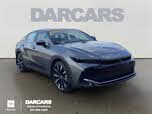Chrysler 300 vs Toyota Crown
Overview | |
Years produced1955-1966 | Years produced1955-1998 |
MSRP$34,295 | MSRP$39,950 |
Listings3168 | Listings2298 |
Ratings & Reviews | |
User Reviews | User Reviews |
Expert reviews5.8 out of 10 | Expert reviews6.3 out of 10 |
Pros
Cons
| Pros
Cons
|
Reviews SummaryThat bellowing is courtesy of a 6.4-liter Hemi, returning to the Chrysler 300 for the first time since 2014. Available only in the limited-production 300C model, it puts enough power to the rear wheels to effortlessly repave the roads with rubber. Fortunately, Chrysler fortifies the 300C with wheel, tire, suspension, and braking upgrades to help drivers make the most of the muscle under the hood. Naturally, there is also an active exhaust system that makes plenty of noise. Verdict: Even as it ages toward retirement, the Chrysler 300 remains a strikingly attractive, large sedan. With an available 6.4-liter V8 engine, it packs the firepower to support its muscle-car looks. However, the aging platform leaves much to be desired in terms of tech, comfort, and safety. | |
Reviews SummaryThe all-new 2023 Toyota Crown finds a unique middle ground between large sedans and SUVs with its elevated ride. Combined with a striking design and unbeatable fuel efficiency, it should have broad appeal, so long as shoppers don't expect impressive performance or decadent luxury. | |
No video found | No video found |
Popular Features & Specs | |
Engine3.6L 292 hp V6 | Engine2.5L 236 hp I4 Hybrid |
Drive TrainRWD | Drive TrainAWD |
Seating Capacity5 | Seating Capacity5 |
Horsepower292 hp @ 6350 rpm | Horsepower |
EV Battery Capacity | EV Battery Capacity1.2 kWh |
MPG City19 | MPG City42 |
MPG Highway30 | MPG Highway41 |
Engine | |
Engine Name3.6L 292 hp V6 | Engine Name2.5L 236 hp I4 Hybrid |
Torque260 lb-ft @ 4800 rpm | Torque |
Horsepower292 hp @ 6350 rpm | Horsepower |
DrivetrainRWD | DrivetrainAWD |
Fuel Economy | |
EV Battery Capacity | EV Battery Capacity1.2 kWh |
MPG City19 | MPG City42 |
MPG Highway30 | MPG Highway41 |
Interior | |
Seating Capacity5 | Seating Capacity5 |
Key Features | |
Navigation System | Navigation SystemStandard |
Safety | |
Front Crash Overall4 | Front Crash Overall5 |
Side Crash Overall5 | Side Crash Overall5 |
Dimensions & Capacity | |
Cargo Space16.3 cu ft | Cargo Space15.2 cu ft |
Curb Weight4013 lbs | Curb Weight4250 lbs |
Height58.5 in | Height60.6 in |
Length198.6 in | Length196.1 in |
Width75.0 in | Width72.4 in |
Wheelbase120.0 in | Wheelbase112.2 in |
Maximum Payload1087 lbs | Maximum Payload905 lbs |
Number of doors4 | Number of doors4 |
Maximum Towing Capacity1000 lbs | Maximum Towing Capacity |
Overview | ||
Years produced | 1955-1966 | 1955-1998 |
MSRP | $34,295 | $39,950 |
Listings | ||
Ratings & Reviews | ||
User reviews | ||
Expert reviews | 5.8 out of 10Read full review | 6.3 out of 10Read full review |
Pros & cons | Pros
Cons
| Pros
Cons
|
Summary | That bellowing is courtesy of a 6.4-liter Hemi, returning to the Chrysler 300 for the first time since 2014. Available only in the limited-production 300C model, it puts enough power to the rear wheels to effortlessly repave the roads with rubber. Fortunately, Chrysler fortifies the 300C with wheel, tire, suspension, and braking upgrades to help drivers make the most of the muscle under the hood. Naturally, there is also an active exhaust system that makes plenty of noise. Verdict: Even as it ages toward retirement, the Chrysler 300 remains a strikingly attractive, large sedan. With an available 6.4-liter V8 engine, it packs the firepower to support its muscle-car looks. However, the aging platform leaves much to be desired in terms of tech, comfort, and safety. | The all-new 2023 Toyota Crown finds a unique middle ground between large sedans and SUVs with its elevated ride. Combined with a striking design and unbeatable fuel efficiency, it should have broad appeal, so long as shoppers don't expect impressive performance or decadent luxury. |
Video | No video found | No video found |
Popular Features & Specs | ||
Engine | 3.6L 292 hp V6 | 2.5L 236 hp I4 Hybrid |
Drive Train | RWD | AWD |
Seating Capacity | 5 | 5 |
Horsepower | 292 hp @ 6350 rpm | |
EV Battery Capacity | 1.2 kWh | |
MPG City | 19 | 42 |
MPG Highway | 30 | 41 |
Engine | ||
Engine Name | 3.6L 292 hp V6 | 2.5L 236 hp I4 Hybrid |
Torque | 260 lb-ft @ 4800 rpm | |
Horsepower | 292 hp @ 6350 rpm | |
Drivetrain | RWD | AWD |
Fuel Economy | ||
EV Battery Capacity | 1.2 kWh | |
MPG City | 19 | 42 |
MPG Highway | 30 | 41 |
Interior | ||
Seating Capacity | 5 | 5 |
Key Features | ||
Navigation System | Standard | |
Safety | ||
Front Crash Overall | 4 | 5 |
Side Crash Overall | 5 | 5 |
Dimensions & Capacity | ||
Cargo Space | 16.3 cu ft | 15.2 cu ft |
Curb Weight | 4013 lbs | 4250 lbs |
Height | 58.5 in | 60.6 in |
Length | 198.6 in | 196.1 in |
Width | 75.0 in | 72.4 in |
Wheelbase | 120.0 in | 112.2 in |
Maximum Payload | 1087 lbs | 905 lbs |
Number of doors | 4 | 4 |
Maximum Towing Capacity | 1000 lbs | |
When comparing the 2023 Toyota Crown and the 2023 Chrysler 300, the first noticeable difference lay in their visuals and presence on the road. The Toyota Crown stood out with its elevated ride height, reminiscent of classic crossover designs like the Honda Accord Crosstour. This 4-inch higher ride made it immediately noticeable, diverging significantly from its predecessor, the Avalon.
The Crown featured a massive grille, although most of this was purely aesthetic. An actual narrow air inlet slit above the grille was flanked by angular headlights that wrapped around the sides of the vehicle, giving the front end a distinctive yet approachable aggression. Large wheels and a black trim piece ran along the bottom of the doors to maintain proportion and break up the otherwise broad expanse of sheet metal. The rear design boasted a rounded shape with a bold taillight strip slicing through a black trim element. However, the stepped transition from the fender to the tail section was a bit unconventional. Higher trims like the Platinum offered a daring two-tone color scheme, which, while not universally liked, demonstrated Toyota’s boldness in design.
Internally, the Crown's cabin mixed modernity with nostalgia. It came equipped with a digital instrument panel and an expansive horizontal touchscreen, though the presence of 1980s-era LED temperature displays disrupted the futuristic feeling. The interior combined hard plastics with cushioned touchpoints, giving it a solid feel. Even though the material quality left some room for improvement, Toyota managed to create an upscale ambiance, easily mistakable for an entry-level luxury car.
Conversely, the Chrysler 300 had a different journey. Introduced in 2005, and often compared to a Bentley Arnage due to its round headlights, bold grille, and stately proportions, it evoked a sense of class and robustness. Over the years, it underwent various stylistic and functional upgrades, particularly in 2011. Despite its age, the 2023 model still carried a sophisticated, timeless appeal.
For its final year, the Chrysler 300 was available in several trims: Touring, Touring L, 300S, and the limited edition 300C. The blacked-out appearance packages with large 20-inch wheels caught the eye, maintaining a modern yet classic appeal. The special edition 300C, with exclusive trims and limited production, added to its allure.
Interior quality was one area where the 300 fell short of its luxury promises. While premium materials like carbon fiber and Laguna leather graced the 300C, the rest of the interior felt dated and did not live up to the external expectations. It retained the charm of its original design, but modern comfort and aesthetics were areas where it clearly lagged behind contemporary competitors.


The 2023 Toyota Crown offered two distinct hybrid powertrains. The standard powertrain featured a 2.5-liter four-cylinder gas engine coupled with a hybrid electric motor, delivering a combined 236 horsepower. This setup, paired with a continuously variable transmission (CVT), provided on-demand all-wheel drive (AWD), ensuring a substantial grip during initial acceleration and when extra traction was necessary. The more powerful Hybrid Max powertrain, available on the Platinum trim, combined a turbocharged 2.4-liter four-cylinder engine with a potent rear electric motor to produce a robust 340 horsepower. This top-tier hybrid coupled with a traditional six-speed automatic transmission promised a more engaging drive.
Toyota estimated that the base hybrid could reach 60 mph in 7.6 seconds, while the Hybrid Max could accomplish the same feat in just 5.7 seconds. However, the overall sensation was that neither model felt exceptionally quick, but they were undoubtedly more powerful than most would need for everyday driving. The CVT in particular made the base hybrid feel less responsive due to its characteristic high-rev droning. In contrast, the six-speed automatic in the Hybrid Max provided a more spirited drive but could still create an unwelcome drone during intense acceleration.
The Crown’s ride was tuned for comfort, with an emphasis on smooth handling rather than sporty cornering. Despite its adaptive suspension in the Platinum trim, the ride did not drastically differ from the base model. Its 4,300-pound curb weight and elevated ride height contributed to a stable and composed driving experience but did not encourage dynamic driving.
On the performance front, the Chrysler 300C was the clear powerhouse. Reviving the spirit of the defunct 300 SRT, it housed a 6.4-liter Hemi V8 engine producing an impressive 485 horsepower and 475 pound-feet of torque. Mated to an eight-speed automatic transmission, it featured a Sport mode and paddle shifters, allowing it to sprint from 0 to 60 mph in just 4.3 seconds and reach a top speed of 160 mph.
The 300C also boasted an adaptive damping suspension, performance-oriented Brembo brakes, and performance tires wrapped around exclusive lightweight forged aluminum wheels. Various driving modes offered dynamic adjustments to the drivetrain, steering, suspension, and exhaust sound. The significant challenge lay in managing the enormous power, especially when activating launch control or stepping aggressively on the throttle.
Driven with care, the 300C delivered an unorthodox yet exhilarating drive. The platform’s roots in mid-1990s Mercedes-Benz E-Class components lent it a distinctive Germanic feel, albeit reminiscent of older AMG models. However, the driving experience came with certain drawbacks, including noticeable exhaust boom and notably poor fuel economy, rated at 18 mpg combined.
Toyota’s approach to the 2023 Crown interior began with seating. The XLE trim featured a blend of fabric upholstery and Toyota’s SofTex faux leather. Moving up, the Limited and Platinum trims sported full leather covers, which felt more premium. The front seats, designed for long-distance comfort, could become uncomfortable due to firm cushioning. Visibility was decent at the front, with a narrow rearview typical of modern sedans. The taller ride height marginally improved road visibility without matching that of an SUV.
Space for personal items was abundant with large cupholders, accommodating door pockets, and a sizeable center console armrest bin. Unique features like the vertical phone tray with a wireless charging pad added practicality, though the armrest lid’s wobbliness was a noted drawback. Rear passengers enjoyed substantial legroom and adequate headroom, although the tapering roofline limited the latter slightly.
Despite a sporty fastback-like profile, the Crown housed a traditional trunk with a respectable opening width and height. However, its total cargo capacity was limited to 15.2 cubic feet, lower compared to competitors like the Kia Stinger (up to 23.3 cubic feet) and Volkswagen Arteon (up to 27.2 cubic feet). This made the Crown’s trunk adequately useful for most needs but not the class leader.
The Chrysler 300’s interior offered a different experience, especially in the 300C trim. Front seats were not just adequately adjustable but featured premium Laguna leather, heating, and ventilation, delivering an above-average level of comfort. Unfortunately, the back seat was less accommodating with hard plastic front seatbacks reducing legroom and an inclined backrest angle not encouraging long-term comfort. Amenities included air conditioning vents, heated outboard seats, and charging ports as consolation.
Storage, or the lack thereof, was a highlight, showcasing the 300’s age. There were few modern amenities like smartphone trays or wireless charging. Instead, it offered a coin dish in front of the shift knob, a relic of past needs. Despite this, it did feature heated and cooled front cupholders, although rear passengers had to make do with uncooled cupholders in the armrest.
The 300’s trunk, while not power-assisted, opened to reveal a spacious 16.3 cubic feet of cargo space, larger than the Crown’s capacity. Enclosed lid hinges prevented belongings from being crushed, adding to its practicality.
Each Toyota Crown came standard with an impressive 12.3-inch infotainment touchscreen featuring sharp graphics and quick response times. The inclusion of wireless Apple CarPlay and Android Auto paired seamlessly with the wireless charging pad, enhancing the modern connectivity experience. The base audio system was sufficient for casual users, while the 11-speaker JBL premium system in higher trims catered to audiophiles.
Over-the-air software updates, a new voice recognition system triggered by “Hey Toyota”, and a digital key feature that allowed smartphone use as a key fob added to the Crown’s technological prowess. These features maintained the infotainment system’s relevance and adaptability.
Meanwhile, the Chrysler 300 was equipped with an older Uconnect infotainment system. Its 8.4-inch touchscreen, while generally user-friendly, appeared dated. Apple CarPlay and Android Auto required wired connections. The system offered basic functionalities like SiriusXM, Guardian connected services, and a voice recognition system but lagged behind the Crown in modern appeal.
A notable feature in the 300C was the SRT Dashboard which allowed settings adjustment for performance monitoring. The control knobs for volume and radio tuning, along with tactile steering wheel controls, were commendable. However, accessing seat heating and ventilation controls required navigating through the screen’s virtual menu buttons.
The 300C’s bass-heavy 19-speaker Harman Kardon system was easy to control but the lack of modern features like a surround-view camera system or high-resolution reversing camera showcased the model’s age. Features like the speed warning alert, while helpful, were often hard to discern over the car’s various noises.
At the time of evaluation, the 2023 Toyota Crown had not yet been crash-tested by the National Highway Traffic Safety Administration (NHTSA) or the Insurance Institute for Highway Safety (IIHS). However, it came equipped with a gamut of standard safety features, including frontal and cross-traffic collision warnings with automatic emergency braking, adaptive cruise control, lane-keeping assist, blind-spot monitor, rear cross-traffic alert, automatic high beams, traffic sign recognition, and a rear-seat passenger reminder. The Platinum trim added a semi-automated parallel parking system. Features such as adaptive cruise control and lane-keeping assist were tuned for smooth driving, reducing the driver's effort but potentially annoying for attentive drivers due to intrusive assistive systems.
The 2023 Chrysler 300, in comparison, was less advanced in terms of safety tech. It included essential features like forward-collision warning, automatic emergency braking, lane-departure warning, lane-keeping assist, blind-spot monitoring, rear cross-traffic alert, and adaptive cruise control. These, however, were optional on all but the fully-loaded 300C. The lane-keeping assist system was effective without being intrusive but lacked haptic feedback, relying instead on visual alerts.
The adaptive cruise control in the 300, though useful, lacked sophistication, unable to resume from a stop autonomously and reacting slower to cars merging ahead. In crash tests, the Chrysler 300 showed signs of its older design, scoring adequately in NHTSA tests but lacking higher ratings in the IIHS assessments.
CarGurus highlights
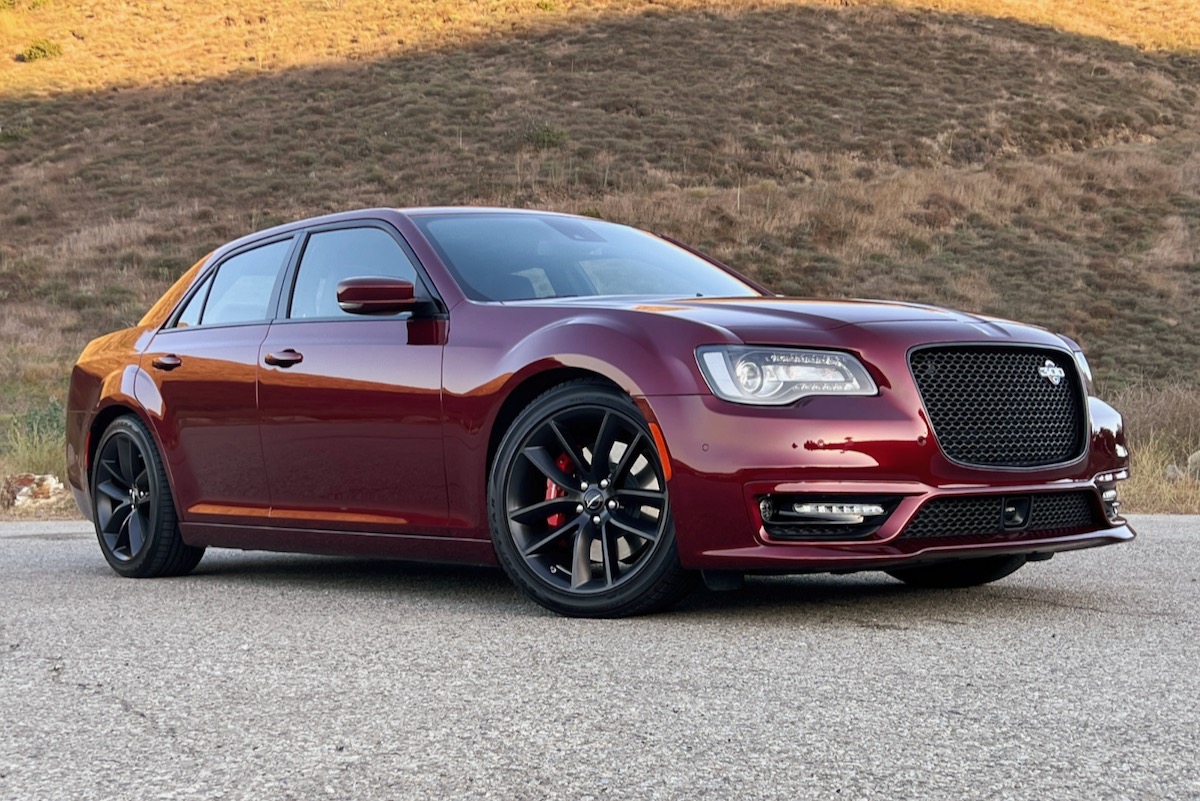
According to CarGurus experts, the overall rating for the 2023 Toyota Crown is 6.3 out of 10, while the 2023 Chrysler 300 scores 5.8 out of 10. Based on these ratings, the Toyota Crown edges out the Chrysler 300 due to its modern technology, extensive safety features, and efficient hybrid powertrains. However, for those seeking sheer power and classic luxury aesthetics, the Chrysler 300 remains a compelling choice.
Choose the 2023 Chrysler 300 if:
- You desire a car with a powerful V8 engine and thrilling performance capabilities.
- You prefer timeless, classic design elements reminiscent of luxury vehicles.
- You need a larger trunk and don’t mind compromising on advanced tech and modern interior design.
Choose the 2023 Toyota Crown if:
- You prioritize modern technology and an extensive suite of standard safety features.
- You value efficiency and smooth driving courtesy of hybrid powertrains.
- You seek a car with a bold, contemporary design and elevated ride height for improved visibility.
CarGurus highlights

According to CarGurus experts, the overall rating for the 2023 Toyota Crown is 6.3 out of 10, while the 2023 Chrysler 300 scores 5.8 out of 10. Based on these ratings, the Toyota Crown edges out the Chrysler 300 due to its modern technology, extensive safety features, and efficient hybrid powertrains. However, for those seeking sheer power and classic luxury aesthetics, the Chrysler 300 remains a compelling choice.
Choose the 2023 Chrysler 300 if:
Shop Now- You desire a car with a powerful V8 engine and thrilling performance capabilities.
- You prefer timeless, classic design elements reminiscent of luxury vehicles.
- You need a larger trunk and don’t mind compromising on advanced tech and modern interior design.
Choose the 2023 Toyota Crown if:
Shop Now- You prioritize modern technology and an extensive suite of standard safety features.
- You value efficiency and smooth driving courtesy of hybrid powertrains.
- You seek a car with a bold, contemporary design and elevated ride height for improved visibility.

By: CarGurus + AI
At CarGurus, our team of experienced automotive writers remain at the heart of our content operation, conducting hands-on car tests and writing insightful guides that are backed by years of industry experience. To complement this, we are harnessing AI to make our content offering more diverse and more helpful to shoppers than ever. To achieve this, our AI systems are based exclusively on CarGurus content, ratings and data, so that what we produce is both unique to CarGurus, and uniquely helpful to car shoppers.
